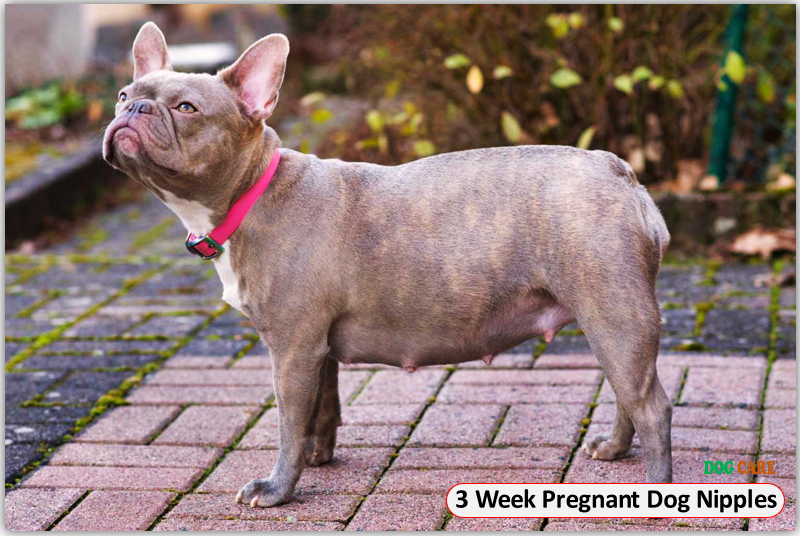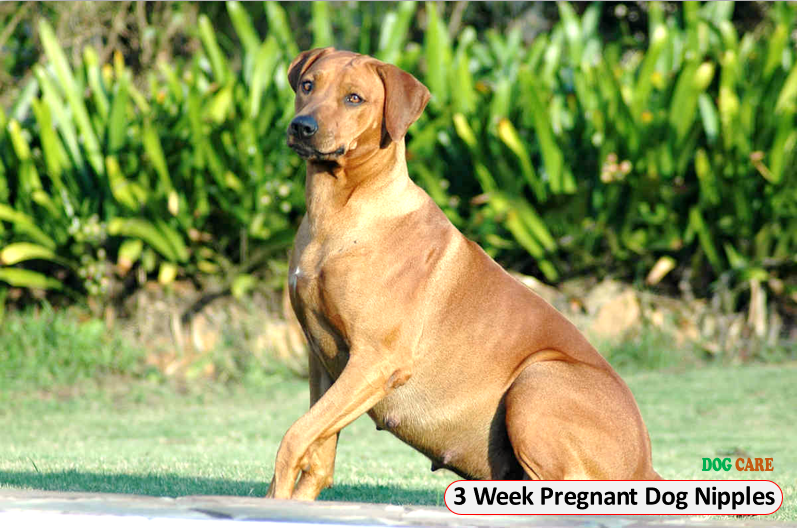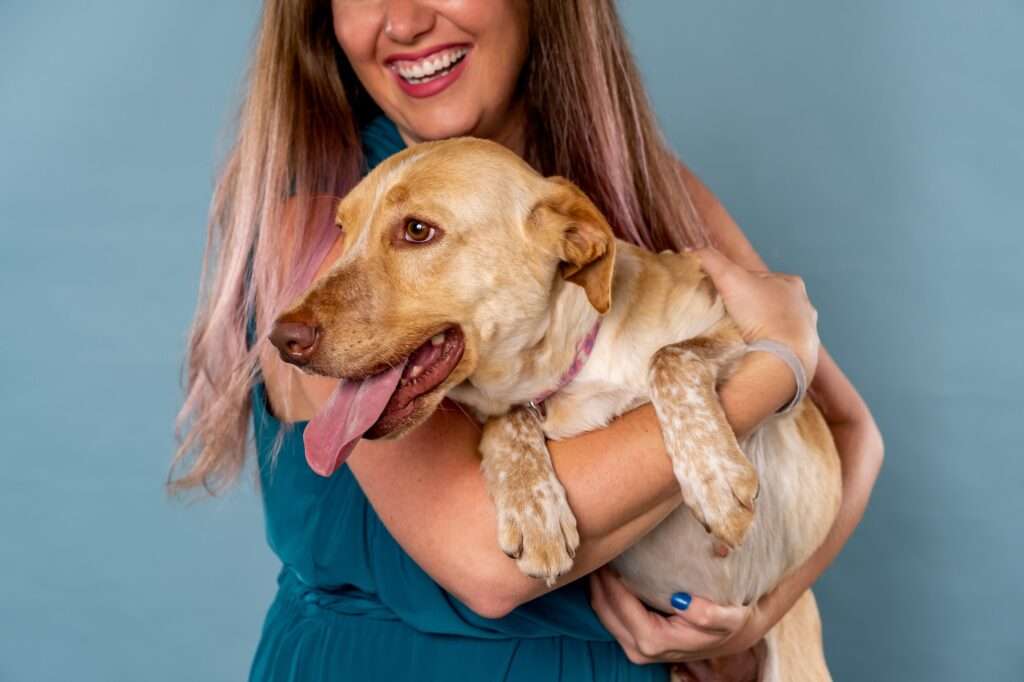3 Week Pregnant Dog Nipples – At three weeks pregnant, a dog’s nipples may become more prominent and slightly pinker. This is a subtle sign of her early pregnancy.
Pregnancy in dogs, also known as the gestation period, typically lasts approximately 63 days. As early as three weeks into the pregnancy, changes in a dog’s body may be noticeable, particularly in the nipple area. Owners might observe that their dog’s nipples are more prominent and may have a deeper pink hue than usual.
These changes are due to increased blood flow and preparation for future milk production. It’s crucial for dog owners to be aware of such changes, as they can serve as an initial indicator of pregnancy, prompting a visit to the vet for confirmation and prenatal care. Providing a nurturing environment and proper nutrition at this stage is essential for the health of the expectant mother and her pups.

Introduction To Dog Pregnancy And Early Signs
Welcome to the exciting journey through the early stages of dog pregnancy! As we delve into the remarkable transformation a female dog undergoes during gestation, it’s fascinating to observe the subtle yet significant changes that occur. Being informed about the early signs of pregnancy in your canine companion is essential for providing proper care and support. Understanding what to look for in terms of behavior and physical changes can ensure a smooth pregnancy for your pet.
Dog pregnancy, or the canine gestation period, usually lasts between 58 to 68 days, with puppies often arriving around the 63rd day. Observing early signs, such as changes in the appearance of nipples, can provide an early indication of pregnancy. Let’s explore the beginnings of this natural process and what signs may signal that puppies are on their way.
Understanding Canine Gestation
The period of gestation in dogs is a complex process that requires careful monitoring. During gestation, a female dog’s body undergoes a series of orchestrated changes to support the development of embryos. The duration of pregnancy is divided into three stages, each with its distinct characteristics and developmental milestones:
- First stage: The embryos implant in the uterus, and early fetal development begins.
- Second stage: The fetuses grow rapidly, developing vital organs and structures.
- Third stage: The puppies continue to mature, and the body prepares for labor.
Knowing these stages helps pet owners recognize what is happening within their dog’s body and makes it easier to spot the early signs of pregnancy.
Recognizing Early Pregnancy
As the owner of a potentially pregnant pooch, it’s crucial to be vigilant about the changes occurring during the first few weeks. Recognizing early pregnancy involves a keen eye and an understanding of canine behavior and physical development. Here are some indicators to help you determine if your dog might be expecting:
- Behavioral changes: Look for increased affection, lethargy, or slight changes in appetite.
- Physical changes: This includes enlarged or pinker nipples, which is especially noticeable in the third week of pregnancy.
- Morning sickness: Some dogs may experience nausea or vomiting in the early stages.
- Weight gain: A slight increase in weight and abdominal distension may be apparent.
- Nesting behavior: As pregnancy progresses, a dog might begin preparing a quiet area for whelping.
The prominence of a dog’s nipples is often one of the first physical signs pet owners will notice. Approximately three weeks into pregnancy, a dog’s nipples can become more prominent, rounded, and darker in shade, due to increased blood flow and the preparation for milk production.
Anatomical Changes In Early Dog Pregnancy
As pet owners begin to anticipate the joy of new puppies, understanding the anatomical changes in early dog pregnancy is essential. A female dog’s body undergoes several transformations to prepare for the nurturing and development of her unborn puppies. During the first three weeks, despite being a relatively quiet period in terms of visible activity, important changes start to manifest internally, setting the stage for pregnancy.
Nipples During The 3rd Week Of Pregnancy
The third week of canine pregnancy is a pivotal time as the bitch’s body confirms pregnancy. During this period, one of the first physical signs pet owners may notice is a change in the appearance of her nipples, which is technically referred to as the mammary glands.
- Size and Color: The nipples may increase in size and become more prominent due to the enhanced blood flow and preparation for later stages of pregnancy.
- Texture: Expect a change in the feel of the nipples as they might become softer to the touch.
These changes serve as an early indicator for breeders and owners, hinting at the need for a nurturing environment and possibly a visit to the veterinarian for confirmation of pregnancy via ultrasound.
Physical Vs. Hormonal Influences On Nipples
Physical alterations in a dog’s nipples are often intertwined with hormonal influences. During the initial three weeks of pregnancy, an interplay of hormones such as progesterone and relaxin drives the changes seen.
| Physical Influences | Hormonal Influences |
|---|---|
| Increased blood flow to nipples | Elevation in progesterone levels |
| Expansion of mammary tissue | Release of relaxin following implantation |
Progesterone prepares the uterus for pregnancy, while relaxin, which is produced after the fertilized eggs implant into the uterus wall, aids in the preparation of the mammary glands. The inception and progression of these changes remain largely subtle to casual observation but are integral to prenatal development.
Observing Nipple Changes In Pregnant Dogs
One of the early signs that a dog may be expecting is a change in the appearance of her nipples. Around the third week of pregnancy, dog owners might start to notice subtle, yet distinct, changes indicating their beloved pet is on her way to becoming a mother. These changes are vital clues and are important to monitor for anyone who is anticipating the pitter-patter of tiny paws. Let’s explore what these changes entail and how they can vary from breed to breed.
Color And Size Alterations
Dog nipples usually undergo noticeable changes in both color and size during pregnancy. What exactly should you look for? As hormonal levels rise and the body prepares for nursing, you’ll likely see the nipples become darker and more prominent. They may shift from a light pink or flesh color to a deeper, more pronounced hue. The nipples also become larger, rounder, and may seem slightly swollen, as they prepare to produce milk.
Breed-specific variations do exist, and these normal changes may appear more prominently in dogs with lighter-colored coats. Conversely, in dogs with darker fur, the coloration might not be as easily observed.
Comparing Nipple Changes Across Breeds
While nipple changes are a universal sign of pregnancy in dogs, their appearance can differ significantly across different breeds. For example, smaller breeds like Chihuahuas may experience more subtle changes, while larger breeds like Labradors tend to show more dramatic differences.
| Breed | Nipple Size Before Pregnancy | Nipple Size During Pregnancy |
|---|---|---|
| Chihuahua | Small, less noticeable | Moderate increase, more visible |
| Labrador Retriever | Already prominent due to size | Significant enlargement |
It’s critical for owners to understand their dog’s baseline nipple appearance to accurately detect these changes. With regular observation, one can quickly become adept at noticing the earliest signs of pregnancy and ensure appropriate care for the expectant mother.
Behavioral Signs Accompanying Nipple Changes
As a devoted pet parent, observing subtle changes in your dog’s behavior might hint at the early stages of pregnancy. Alongside physical transformations, such as nipple development, canines exhibit a medley of behavioral signs that suggest they are expecting. These signs, beyond the observable changes in their nipples, are essential clues that help in preparing for the upcoming litter. Let’s explore how appetite fluctuations and nesting behaviors correlate with the progression of your dog’s pregnancy and what they mean for the health and comfort of your furry friend.
Appetite Fluctuations in Early PregnancyAppetite Fluctuations In Early Pregnancy
One of the first telling signs a pet owner may notice is a shift in their dog’s eating patterns. While some dogs may show an increased appetite, others may experience a period of reduced interest in food. These changes are a normal part of the hormonal upheaval that accompanies pregnancy.
- Increase in Hunger: Expect your dog to possibly crave more food as her body begins to support the growing pups. Her nutritional needs will elevate.
- Selective Feeding: Your dog might become pickier, favoring certain types of food as her taste preferences change.
- Decrease in Appetite: Conversely, morning sickness due to early pregnancy hormones may cause a temporary decrease in appetite.
It’s crucial to monitor her eating habits and consult a veterinarian if you notice extreme changes. Dogs in the blossoming stages of pregnancy require a balanced diet to ensure the health of both the mother and her puppies.
Nesting Behaviors and Their Relation to Nipple DevelopmentNesting Behaviors And Their Relation To Nipple Development
As the pregnancy progresses, typically around the third week, expectant dogs may start displaying nesting behaviors. This innate compulsion is a primal instinct preparing for the arrival of her young. Markers of this behavior include:
- Seeking Seclusion: Your dog may begin to search for quiet, secluded spaces. It’s a sign she’s looking for a safe place to give birth.
- Gathering Comfort Items: Don’t be surprised to find your dog collecting soft materials or her favorite toys. She’s creating a comfortable birthing area.
- Restlessness: An expecting mother might exhibit an unusual level of activity as she prepares her nest.
These behavioral adjustments often go hand-in-hand with the physical sign of nipple changes, such as enlargement or color darkening, as her body gears up for nursing. Observing these instinctive actions provides invaluable insight into your dog’s reproductive status and allows you to support her through these critical early stages of pregnancy.
The Importance Of Veterinary Confirmation
The Importance of Veterinary Confirmation can’t be overstated when it comes to understanding the reproductive status of your pet. At three weeks, you may notice physical changes in your dog, such as the swelling of nipples, which could suggest pregnancy. However, relying solely on such signs can be misleading. It’s essential that pet owners seek professional veterinary diagnosis to avoid misinterpretation and to receive guidance for proper prenatal care. Let’s delve into why professional input is vital and what limitations mere observation may have.
Limitations Of Nipple Observation
While the changes in a dog’s nipples, such as enlargement or darkening, can indicate pregnancy, they are not definitive proof. A variety of factors could cause similar symptoms, including hormonal fluctuations unrelated to pregnancy. Here are some points to consider:
- False Pregnancy: Dogs can exhibit signs of pregnancy, including nipple enlargement, even when they’re not pregnant, known as a false pregnancy or pseudopregnancy.
- Hormonal Variabilities: Hormones like progesterone and prolactin can cause physical changes that mimic pregnancy.
- Breed Differences: Certain breeds may naturally have more prominent nipples, which can be misleading.
- Health Conditions: Other medical conditions can cause nipple changes, demanding professional assessment to rule out issues such as infections or tumors.
Seeking Professional Diagnosis
Consulting a veterinarian ensures an accurate pregnancy diagnosis through comprehensive examinations and diagnostic tools. Vets might perform the following:
- Physical Examination: A vet will palpate the abdomen to detect signs of embryos, albeit this is more effective in the later stages of pregnancy.
- Ultrasound: An ultrasound can confirm pregnancy as early as three weeks, providing a visual of the developing embryos.
- Blood Tests: Hormone-level tests can confirm pregnancy by measuring relaxin, a hormone that’s present only when a dog is pregnant.
- X-Rays: While typically done later in the pregnancy, X-rays can provide a count of the number of puppies to expect.
Correct diagnosis is crucial for the health of the expectant mother and her offspring. It allows for proper prenatal care and helps prepare for a healthy delivery.
Caring For A Dog In The Early Stages Of Pregnancy
Welcome to the tender stage of a dog’s early pregnancy, where even the subtlest changes are harbingers of the new life blossoming within. Around three weeks in, dog owners may observe a remarkable change in their furry friend’s physical traits, especially the enlargement and pigmentation changes in their nipples. This physiological transformation signals the need for an attentive and nurturing approach towards the expectant mother. It’s crucial for pet parents to familiarize themselves with the proper care required to ensure a healthy pregnancy for their canine companion.
Nutritional Demands And Diet Adjustments
Optimum nutrition during the embryonic stage sets the foundation for a healthy gestation. At three weeks pregnant, a dog’s body begins to demand more calories and vital nutrients to support the growing litter. The following points encapsulate the dietary needs:
- Highly Digestible Meals: Serve easily digestible foods enriched with essential nutrients.
- Protein Uptake: Incorporate quality proteins to foster fetal development.
- Fatty Acids: Include sources of omega-3 and omega-6 to aid in healthy brain and eye development.
- Small, Frequent Feedings: Transition to smaller, more frequent meals to ease digestion and provide a steady supply of nutrients.
It is advisable to consult with a veterinarian who may recommend a structured nutritional plan or prenatal vitamins, tailored specifically to your dog’s needs. Owners should
| Week of Pregnancy | Recommended Dietary Change |
|---|---|
| Week 3 | Gentle increase in calories, introduce premium-quality puppy food |
| Weeks 4-6 | Steady caloric increase, monitor weight gain to prevent obesity |
| Weeks 7-9 | Peak in calorie needs, maintain or slightly increase food quantity |
Ensure a gradual transition to avoid gastrointestinal disturbances. Hydration remains paramount, so fresh water should always be available.
Exercise And Activity Considerations
Maintaining an optimal level of physical activity is essential during a dog’s pregnancy, but adjustments in the routine must be made. During the third week of gestation, dogs should remain active to support their health; however, strenuous activities or high impact exercises should be avoided. Consider the following for a pregnant dog’s exercise routine:
- Moderate and consistent daily walks maintain muscle tone and overall fitness.
- Avoid vigorous training, jumping or any activity with potential for abdominal trauma.
- Provide ample rest periods between activities and monitor for signs of fatigue.
- Always ensure access to clean, fresh water during and after exercise.
It’s critical to pay attention to the dog’s comfort level during exercise and adjust accordingly. A veterinarian’s guidance can provide additional insight for exercise frequency and intensity suited to your dog’s breed, age, and health condition. Encouraging gentle play and providing a stress-free environment will also support your dog’s wellbeing throughout pregnancy.
Caring for a three-week pregnant dog goes beyond adjusting nipples; it encompasses a holistic approach involving dietary management and exercise moderation. With the right care and awareness, you can ensure a healthy journey for both the expecting mother and her future puppies.
Potential Complications Mirroring Nipple Changes
As a dog owner, noticing alterations in your pregnant dog’s nipples can be both exciting and nerve-wracking. While nipple changes often signal a normal pregnancy, they can also indicate potential complications. Understanding the nuances of these changes is vital to ensuring the health of your expecting pet.
Distinguishing Pregnancy From False Pregnancy
False pregnancies in dogs, also known as pseudopregnancies, can cause physical and behavioral symptoms that closely mimic those of a true pregnancy. Nipple enlargement is a common sign in both conditions. To differentiate, lookout for other pregnancy indicators such as:
- Weight gain
- Increased appetite
- Nesting behavior
- Possible abdominal distention
Observing these signs alongside nipple changes can confirm pregnancy. Always consult your vet for an accurate diagnosis, as they may recommend an ultrasound or other tests to differentiate between a true and false pregnancy.
Health Concerns And Abnormal Changes
Being proactive about your dog’s nipple health can preempt complications. Watch for abnormal changes, which may include:
| Sign | Possible Indication |
|---|---|
| Discoloration | Infection or Mastitis |
| Discharge | Hormonal imbalance or infection |
| Swelling | Mastitis, tumor, or abscess |
If you observe such symptoms, contact your veterinarian immediately. Early detection and treatment are crucial for the well-being of the mother and her puppies. Proper prenatal care, including regular check-ups, is essential for monitoring the health of your dog’s nipples and the overall pregnancy.
Planning For Whelping: Preparing For Puppies
Welcome to the critical phase of your dog’s pregnancy where early signs, like changes in nipples, are noticeable, and planning for whelping becomes pivotal. As a responsible pet owner, preparing for the imminent arrival of puppies entails creating a conducive environment for the birth process. In this guide, we’ll walk you through setting up a perfect whelping area and understanding the timeline and stages leading to birth.
Creating A Whelping Area
Establishing a comfortable and secure whelping area is essential for a smooth and stress-free birthing process for your expecting dog. Here are the steps to take:
- Choose a Quiet Location: A low-traffic, serene spot shields the mother from unnecessary stress.
- Opt for Easy-to-Clean Surfaces: Non-porous flooring simplifies cleanup post-birth.
- Include a Whelping Box: A spacious box lined with soft, absorbent bedding provides a safe spot for delivery and nursing.
- Control Temperature: Maintain a warm area to prevent chilling of the newborn puppies.
- Prepare Emergency Supplies: Have on hand clean towels, scissors, iodine, and contact details for your vet.
By setting up ahead of time, you help ensure a controlled environment ready for the coming littles.
Timeline And Stages Leading To Birth
Understanding the stages of canine pregnancy helps you anticipate and support your dog’s needs:
| Weeks | Developmental Milestones | Owner Actions |
|---|---|---|
| Week 1-2 | Fertilization and early cell division. | Provide a balanced diet and avoid strenuous exercise. |
| Week 3 | Nipples begin to enlarge; early embryo development. | Observe physical changes, such as nipple growth; schedule a vet visit for pregnancy confirmation. |
| Week 4-5 | Embryos implant in the uterine lining; detectable heartbeats. | Continue nutritional support; limit physical stress on the mother. |
| Week 6-9 | Rapid fetal growth; the mother prepares for whelping. | Prepare the whelping area and assemble necessary supplies. |
Monitoring each developmental stage ensures you provide the right care at the right time. By week three, when dog nipples enlarge, it’s an early indicator of pregnancy, signaling it’s time to get your whelping preparations underway.
Faqs About Canine Pregnancy And Nipple Observations
Welcome to the frequently asked questions section about canine pregnancy and nipple observations. When your beloved dog becomes pregnant, curious changes begin to take place. Among them, the nipples often become a point of intrigue. Pet owners may notice several alterations as their furry friend progresses through pregnancy, and it’s essential to understand these changes.
Understanding Nipple Discharge
Nipple discharge in a pregnant dog is a normal occurrence, especially as she gets closer to delivery. During the third week of pregnancy, you might start seeing physical changes such as slightly enlarged nipples or even small amounts of discharge. Here’s what to keep an eye on:
- Color: Clear or slightly milky discharge is typical.
- Consistency: In most cases, the discharge remains thin and fluid.
- Quantity: A small amount of discharge is expected; however, excessive discharge could warrant a vet visit.
It’s critical to monitor the nipples for significant changes or signs of infection, including changes in color, thickness, or smell of the discharge. Any concerning signs should prompt a consultation with your veterinarian.
Managing Male Dogs Around A Pregnant Female
During pregnancy, it is often advised to keep male dogs away from a pregnant female to prevent unnecessary stress or injury. Managing male dogs around your pregnant pet requires some precautions:
- Separation: Ensure the pregnant dog has her own quiet space, away from male dogs.
- Supervision: Never leave male dogs unsupervised with the pregnant female.
- Behavioral Changes: Both male and female dogs might exhibit behavioral changes; monitor and address these promptly with the help of a professional if needed.
Keeping stress levels low is vital for a healthy pregnancy, so providing a peaceful environment for your pregnant dog will support her well-being throughout the gestation period.
Conclusion: Monitoring Nipples As Part Of Overall Prenatal Care
As we wrap up our discussion on the delicate signs of a dog’s pregnancy, focusing on the alterations in the nipples is imperative. Monitoring the physical changes, particularly in the nipples, serves as a key aspect of comprehensive prenatal care for your expecting canine. As part of responsible pet ownership, thorough observation ensures that your dog receives the attention and care necessary for a healthy pregnancy.
The Role Of Responsible Breeding
Responsible breeding transcends beyond the act of mating selected dogs. It encompasses a deep understanding of canine health, genetics, and prenatal care. Breeders must ensure that they are prepared to provide meticulous observation from the moment of conception, especially as the dog’s body undergoes significant changes. Nipple monitoring, alongside regular veterinary check-ups, serves as a cornerstone in detecting any abnormalities early and adjusting care as needed.
Continued Care And Vigilance Throughout Gestation
Vigilance throughout gestation is essential in nurturing the expecting mother to full term with minimal complications. By keeping a close eye on changes in nipple size, color, and texture, breeders and pet owners can gather valuable insights into the health of the mother and pups. A transformation in the nipples often indicates the progression of the pregnancy and impending labor. It’s crucial to maintain a log of observations and seek veterinary guidance if any concerns arise, securing the wellbeing of the pregnant dog during this sensitive period.
Frequently Asked Questions Of 3 Week Pregnant Dog Nipples
What Changes Occur In Dog’s Nipples At 3 Weeks?
At three weeks pregnant, a dog’s nipples may become larger, darker, and more pronounced as her body prepares for nursing.
Are Swollen Nipples A Sign Of Dog Pregnancy?
Swollen nipples can be an indication of pregnancy in dogs, typically noticeable around the third week.
How To Identify A Pregnant Dog’s Nipples?
Pregnant dog nipples tend to enlarge, darken, and become more evident compared to when she’s not pregnant.
Is Nipple Color Change Normal In Pregnant Dogs?
Yes, it’s normal for a pregnant dog’s nipples to change color, usually darkening, as part of hormonal changes.
Can You Touch A Pregnant Dog’s Nipples?
While gentle handling is usually fine, it’s important to be cautious and avoid causing discomfort to a pregnant dog.
What Care Is Needed For 3-week Pregnant Dogs?
Provide balanced nutrition, gentle exercise, and avoid stress to ensure the well-being of a dog at 3 weeks pregnant.
Do Dogs’ Nipples Revert Post-pregnancy?
Post-pregnancy, a dog’s nipples may somewhat reduce in size but might not return completely to their pre-pregnancy state.
How Does Pregnancy Affect Dog’s Nipples Long Term?
Pregnancy can result in permanent changes in a dog’s nipples, including size and pigmentation, due to hormonal influences.
When Do Pregnant Dogs Start Showing Nipple Changes?
Nipple changes often start to become visible around the third week of a dog’s pregnancy.
What Are Other Early Signs Of Dog Pregnancy?
Other early signs of pregnancy in dogs include slight weight gain, increased appetite, and possibly morning sickness.
Conclusion
Wrapping up our journey through the early days of canine pregnancy, the changes in your fur baby’s nipples are a clear sign of new life stirring. As your pet’s body prepares for motherhood, these transformations are both expected and natural.
Remember, proper veterinary care is crucial during this delicate stage. Your awareness and attention to her needs can ensure the health of both the mother and her future puppies. Keep observing, and prepare to embrace the joy of little paws soon!



